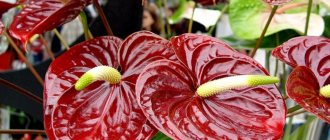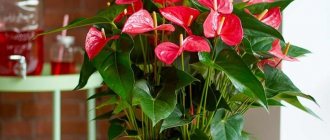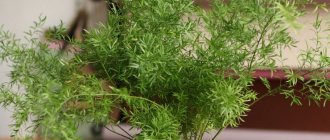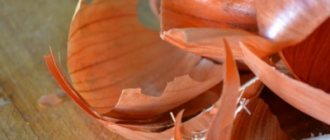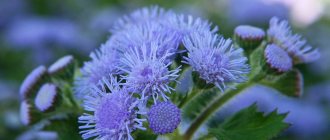Anthurium flowers amaze with their beauty. This tropical plant can bloom all year round if well cared for. They can be cut and formed into gorgeous bouquets.
Men's happiness is able to absorb kitchen odors and odors emanating from plastic, so by placing a flowerpot in the dining area, you will breathe clean air enriched with oxygen.
There are about nine hundred species of this flower in the wild.
Home care
Anthurium has its own care characteristics that should be taken into account when caring for the plant. And then it will delight you with almost year-round flowering.
Location and lighting
The subtropical guest prefers light and warmth. Only the light must be diffused. Also make sure that the flowerpot does not stand in a draft - this will not do it any good. If possible, take the flowertail outside in the summer. Only the place should be calm and slightly shaded from the sun.
The best place for anthurium is east or west windows. You can keep it on a southern windowsill in winter, but in summer it is better to move it to a table near the window. If the apartment's windows face exclusively north, the red tongue may not bloom. Therefore, be sure to add lighting in winter.
Temperature
Try to provide the anthurium with a favorable temperature regime. In spring and summer it should be warm: +22-28°C. In the cold season, maintain the temperature at least +16-18°C. If the room has less degrees than required, add additional lighting with a lamp. Otherwise, the red tongue may get sick.
Watering
In the warm season, water the anthurium 2-3 times a week. In winter, once a week will be enough. Fill in a lot of water. Before watering, let it sit and warm up to room temperature. To prevent the roots from rotting, wait until the soil becomes barely moist and only then water again.
Air humidity
The air humidity around the pot should be high to such an extent that droplets of moisture appear on the leaves. So take appropriate measures:
- you can spray the anthurium 2-3 times a day;
- spread the wet expanded clay in a tray and moisten it every day;
- cover the pot with sphagnum moss;
- place containers with water nearby;
- wipe the leaves with a damp cloth;
- Once a week, give your ward a warm shower for the leaves, having previously covered the soil with polyethylene, returning it to its usual place when the water has completely drained from the leaves.
Make sure that when spraying, droplets of moisture do not fall on the cob, otherwise the flower will become covered with ugly spots. If you accidentally drop it on a flower, immediately remove the moisture with a cotton swab.
The soil
The soil for anthurium should have good air permeability and be loose. Prepare the following composition:
- 40% peat;
- 40% turf;
- 20% crushed sphagnum.
You can take ready-made soil for begonias and add a little coconut fiber, coal, and chopped fern rhizomes to it.
It is advisable to season both the first and second options with small pieces of brick and pine needles.
Feeding and fertilizers
It is necessary to feed flowertail in spring and summer. Add mineral fertilizers once every 2-3 weeks. Only reduce the dose indicated on the package by half.
When replanting, add rotted manure. Don’t throw away the dry leaves, but dig them in the pot. They will rot and also turn into fertilizer. If you take the flowerpot outside, you can water it with a liquid infusion of chicken droppings.
Transfer
A young flower must be replanted every year. As a last resort, do it after two years. And adult plants can live in the same flowerpot even for three years in a row. Notice that the roots have become crowded, which means it’s time to replant.
Try to carry out the procedure in February-March. Handle the roots and leaves very carefully as they are thin and fragile. Choose a flowerpot a little larger than the previous one - literally 1-2 cm, since anthurium does not like space and may not release color in a container that is too large. Give preference to plastic, because it will be hot in a ceramic flowerpot. The container should be long and not very wide. Line the bottom with a layer of broken brick or expanded clay.
Please note that this flower is poisonous, so wear gloves. And choose a place such that neither children nor animals can reach it. If a leaf is bitten off, a food allergy may occur.
Why are there no buds?
Note! Anthurium begins to bloom at the age of one to 4 years.
Your plant is probably not ready yet.
- The soil is not moist enough.
- There is not enough light.
- Anthurium is subject to drafts.
- Repeated rearrangement.
Watch the video about why Anthurium does not bloom and 7 ways to make it bloom:
On our website there are other materials about anthurium: diseases and pests of the flower, reproduction, benefits and harm for humans and animals, differences from “female happiness”.
Bloom
In order for the anthurium to have the opportunity to set buds, it is necessary to keep it cool in winter, lowering the temperature to 15-16 degrees. In this case, the ward will thank you with flowering throughout the summer. Some species produce color all year round.
After a month or a month and a half, the flower needs to be removed so that it does not begin to form seeds and take away the strength from the bush.
This representative of the Araceae family does not bloom only if the maintenance conditions are violated: temperature, humidity, lighting, watering. Do not overdry the soil or flood the soil too much. Fertilizers should be used. And then you will invariably see a bright pink cob framed by a blanket sheet.
Anthurium can be cut and formed into bouquets. The cut bud will last in the vase for about five days. And a flower that has already bloomed enough will not wither for 25-30 days.
Kinds
Anthuriums are the most numerous representatives of their family. According to some sources, the number of species of this plant is more than 500. But as it turned out, this is already outdated data; modern scientists have expanded the list to 900 items. The most popular in indoor floriculture are several species that are valued for their decorative qualities.
| Types and varieties | Description |
| Anthurium Andre | Herbaceous evergreen perennial. The leaves, similar to an elongated heart, are located on a long petiole and have a rather large size - length up to 30 cm, width - 10 - 12 cm. The surface of the leaf plate is dense, semi-glossy, green in color. The broad-heart-shaped spathe is slightly wrinkled, with pronounced veins, and glossy. The color can be different - salmon, pink, red, less often white. The inflorescence is a yellow spadix up to 10 cm long, erect or sometimes drooping. This species is very decorative and is very popular among gardeners. |
| Anthurium Andre Champion | A varietal plant of medium size and surprisingly beautiful dark green foliage. The flowers are small, but Champion is famous for their abundance. The color of the bedspread, depending on the variety, can be pink or white with a slight yellowish tint. |
| Anthurium Scherzer | Epiphyte, sometimes a terrestrial plant with a short stem. The petiole on which the leaf is attached has a length of 4 to 20 cm. Elliptical or lanceolate leaves with a pointed apex have a dense structure. The surface is glossy on top, matte on the bottom. The color is dark green. The distinctive feature is the flower. The bedspread is painted in red-orange color, which does not lose its brightness for a long time. The surface is glossy, the structure is medium density. The inflorescence is a spirally twisted ear, colored yellow or orange. One of the most popular potted species. |
| Anthurium crystal | Leads an epiphytic lifestyle. The leaves are large, almost 40 cm in length. They have an elongated oval shape, with a pointed apex. Deeply lobed at the base. Prized for their unusual color. Against a dark green background, the vein areas, painted silvery-white, stand out in contrast. The blanket is small - up to 9 cm, semi-leathery, green. The inflorescence is a yellow spadix tapering towards the apex, 12 cm long. |
| Baker's Anthurium | Epiphyte with stems 10 cm long. The leaves are narrow, elliptic-lanceolate, from 20 to 55 cm long. The leaf blade is matte, dark green on top, lighter on the undersides. The flowers are inconspicuous, located below the foliage level. The cover is small, from 2.5 to 5 cm long. The surface is leathery, painted in pale yellow-green tones. There is a purple border along the edge. The inflorescence is an 11-centimeter spadix of white-cream color. |
| Anthurium mix | This is a group of hybrids obtained on the basis of common species - Andre and Scherzer. Perfectly adapted to home conditions, they do not require special attention. As a rule, these plants have compact sizes and a variety of colors of bedspreads. |
Species and varietal diversity of anthurium - photo gallery
Anthurium Andre flowers captivate with their beauty. Anthurium Andre Champion has slightly smaller flowers, but more in number.
Anthurium Scherzer is distinguished by a spiral-shaped inflorescence
Crystal Anthurium has luxurious foliage Baker's Anthurium looks completely different from other species
Anthurium mix - color variety of hybrid plants
How to choose a flower
It is best to buy a pot with a ready-made plant in the summer. During this period, anthurium has a lot of strength and will more easily endure acclimatization in new conditions. Under no circumstances should you place the potty in the bedroom. Only in the kitchen or living room.
Take a close look at the copy offered for sale:
- all parts must be proportional;
- the pot should not be too small;
- the roots should not come out of the holes at the bottom;
- there should be no pests on the bottom of the largest leaves;
- there should also be no gray or black spots on the leaves;
- the soil in the container should be moist;
- A flowering plant must have unopened buds.
How to rejuvenate anthurium
A bush with a considerable age has a bare trunk. This is due to the fact that the lower leaves gradually die off. As a result, the flowers become smaller or even do not appear at all. What to do in this case? Rejuvenate your pet.
During transplantation, cover the top with moss and wait for roots to appear. After this, separate the cuttings and plant them in a pot. You can cut off the apical stalk along with the aerial roots and place it in a jar of water. Just make sure the outlet is outside. In this case, there is a danger of the sprout rotting.
And in order not to mess around, you can restore your former youth by polishing the leaves with special polishes. This procedure will not only give the plant beauty, but also create a protective barrier for pests.
What it is?
Anthurium is a genus of evergreen plants that belong to the Araceae family .
There are species with short stems and aerial roots, as well as species with long vines. The leaves are all fatty, juicy, and come in different shapes - cut or whole. The sizes of the leaf plates can also be different - some types reach 1 meter. The foliage is decorative - many of the species are velvety, with light veins or a satin tint. Anthurium flowers are bright, original in appearance, the buds are collected in dense inflorescences. After the buds fade, fruits similar to berries appear on the shoots.
Anthurium is a whimsical, capricious plant that requires constant maintenance of certain conditions. In total there are more than 500 varieties. This family is considered one of the most numerous.
This plant is also popularly called “male happiness.” It is often paired with spathiphyllum, which is called “female happiness.” It is believed that if these plants are present in the house, mutual understanding and harmony will reign in the family.
The plant does not release toxic substances into the air, but its juice in contact with mucous membranes can cause burns. And if swallowed, it can lead to poisoning.
Reproduction
Anthurium can be propagated in different ways. And they are all about equally successful.
Dividing the bush
This method is most often used. During transplantation, carefully divide the bush into two or three parts. Make sure that each of them has a growth point. Do not use a knife, tear it off with your hands. Otherwise, you may damage the delicate roots. Plant each of the divisions in a separate pot. Water well and place close to light, but not in direct sunlight. Start feeding new plants after a month.
By shoots
Solid anthuriums gradually acquire side shoots. You can separate them and plant them in a separate container. Do this during transplantation to avoid damaging the roots. And if you urgently need to get a shoot, then remove the bush from the pot along with the earthen lump and carefully separate the planting material.
If there are very few roots on the shoot, first plant them in sand for rooting, covering the top with an inverted plastic bottle. Keep in a warm place, ventilating the sprout from time to time. After roots appear, transplant into a pot.
Cuttings
Separate the cutting. Air dry it for a quarter of an hour, then place it in a jar of water. Stretch polyethylene over the top. Wait until the roots appear in about a week and plant the man's happiness in the soil mixture.
Leaves
Cut an anthurium leaf, roll it into a tube and tie it with woolen thread. Stick halfway into the peat moss mixture, moisten thoroughly and cover with a jar. Keep in a dark place for three weeks. When a sprout appears, move it to light, but not to the sun. After three days, remove the jar. After a month, transplant it to a permanent place.
Seeds
Having purchased anthurium seeds in a store, sow them in peat, sprinkle the surface and cover with cellophane film. Shoots will begin to appear gradually in a couple of weeks. Wait until all the seeds hatch, then remove the film.
Continue spraying the seedlings with a spray bottle. Dive into 10cm pots after the third leaf appears.
If you decide to collect seed material yourself, be sure to carry out pollination. Use a brush to transfer pollen from one flower to another. Repeat the procedure after two days. To be sure, you can do this again.
For the fruit to ripen, wait 8-10 months. After this, remove the seeds, rinse and soak for 2 hours in a weak solution of potassium permanganate. Then immediately plant them in the soil mixture, sprinkling a layer of perlite on top.
Scatter the seeds over the surface, lightly press them into the ground and spray. Place glass on top. Keep the seedlings at a temperature of +22 degrees for two weeks. Then the first shoots should appear.
Wait for a pair of leaves to form and plant the sprouts in small pots. As soon as they grow up, transplant them into larger containers. They should bloom in 2 years. At first the flowers will be weak, but every year they will improve their appearance.
Common problems when growing
Problems when growing anthurium are most often caused by insufficient feeding and incorrect temperature conditions. You should also check the humidity in the room.
With leaves
If the leaves of the plant dry out or turn yellow, you should increase watering and carry out emergency feeding. These measures will help compensate for the lack of nutrients. You should also inspect the flower for pests.
Turn yellow
If the leaves turn yellow, the plant does not have enough potassium. You can add ash as an organic fertilizer or feed the flower with a complex composition for indoor plants. Additionally, loosening should be carried out.
The ends are drying out
It happens that the edges of the leaf plates of a flower begin to dry out very much. In this case, you should check the humidity in the room. If it is insufficient, you should purchase a humidifier, and the problem will be resolved. It is not difficult to revive the plant.
Curl up
Curling leaves is a sign of lack of heat. This often happens in winter. In this case, you should turn on the heater in the room or place a table lamp for heating next to the flower. In summer you need to move the flower closer to the sun's rays.
Stains
Brown and rare yellow spots on buds or leaves are signs of rust. At first, the leaves simply become dark and dry, then, if the problem is not addressed, black spots appear and rust moves from the leaves to the roots. The reason is excess moisture. The solution is to reduce air humidity and watering.
Pale
The leaves and stem turn pale from lack of nutrients. The solution is comprehensive and regular feeding. You can also transplant it into a more spacious and suitable pot, then you will be able to save the flower.
With roots
Antorium has a developed and powerful, but vulnerable root system. If you touch the root during transplantation, the flower may die. Any problems with roots are very dangerous.
Aerial roots
If the flower has aerial roots under the leaves, then it is time to transplant and propagate the plant. The top of the stem with aerial roots needs to be rooted, it is cut off and transplanted into another pot. After this, be sure to water thoroughly.
The roots are rotting
Root rot is often the result of a fungal infection. To solve the problem, spraying with fungicides is used. Replanting to remove the rotten part of the roots also helps.
With barrel
You can determine the condition of a flower by its trunk. If the trunk becomes brittle and fragile, and the leaves on the trunk fall off, then the flower is sick and needs treatment.
The trunk is exposed
Bareness of the trunk is a sign of a lack of iron and sunlight. Comprehensive feeding and moving the anthurium to a window that faces the sunny side will help.
The trunk stretched out
It happens that the trunk stretches disproportionately. In this case, the plant lacks potassium and calcium. As a top dressing, you can use complex fertilizers, as well as tea leaves and eggshells.
Withers
Wilting of the trunk is a sign of a fungal or viral infection. To solve the problem, spraying with a fungicide or antiviral agent for indoor plants, for example, Inta-vir, is required.
Crying
It happens that moisture appears on the leaves of the anthurium. When such drops of water appear, it seems as if the flower is crying. This is normal after heavy watering; the reason is that the plant gets rid of excess water. There is no need to treat this condition. If the room has dry air, the plant will not cry.
Diseases and pests
If you care for anthurium incorrectly, you can provoke the appearance of diseases.
Anthracnose
With this scourge, brown spots appear on the stems and leaves. Gradually they become brown and dry out. The plant will die if rescue measures are not taken in time. Remove infected areas and treat the remaining areas with fungicides.
White rot
The leaves become covered with a white coating, losing their natural color. The disease usually begins on the lower leaves. Fungicides or Bordeaux mixture will help cure flowertail.
Soil fungi
Replanting into new soil will help. Remove damaged roots and treat healthy ones with potassium permanganate.
Gray mold
Replant into a new pot, increasing the drainage layer, and then regularly ventilate the room.
Parasites
In addition to diseases, the plant can be attacked by spider mites, scale insects, thrips, and aphids. They should be gotten rid of with insecticides or acaricides. You can try soaping the leaves with a solution of laundry soap. Leave for several hours, then rinse.
Popular colors
Most often, domestic gardeners grow anthurium in the following colors:
- red;
- white;
- pink;
- yellow.
There are other colors, for example, variegated or two-tone; however, they are less common.
Red
The red spathe picturesquely sets off the dark green leaves; the bract is usually also red, but a little lighter or darker. The most popular red varieties are Cavalli, Majestic, Sierra Magic.
White
If the spathe is white, the bract is usually red, beige or pinkish. These varieties usually bloom for a long time. The most popular types are Utah, Adios, Amalia Elegance. White stands out effectively against the background of dark foliage.
Pink
Usually pink varieties are short growing. The most common varieties are Jolie, Lady Love and Pink Champion. Most pink varieties are hybrids and have been recently developed. They are unpretentious in content.
Yellow
Shades of yellow vary, ranging from pale lemon to canary. The list of the most popular varieties includes Picasso and Princess Alexia. Most yellow varieties are tall, up to 70 cm in height.
Orange
The most popular varieties are Baby Orange, Madural Orange and Rainbow. Orange varieties are very popular due to their contrast with dark green foliage. Usually the flowers appear at the same time as the berries.
Violet
Purple anthurium most often comes in the following varieties: Cavalli Purple, Utah and Fiorino. All these are artificially bred varieties that have good immunity. The blanket changes color from light pink to dark purple.
Green
The list of the most popular varieties includes Green King, Midori and Baby Green. These are medium-sized varieties, 40–45 cm high. The bract is usually also green or brown.
Blue
Blue and blue varieties of anthurium have not yet been developed. Blue shades are produced artificially by dyeing white flowers. However, breeders are working to produce flowers with a blue trail.
Care errors
Carefully monitor the green ward to eliminate all the shortcomings in time:
- the tips of the leaves have dried out - heat the bush under a table lamp with a regular light bulb;
- the leaves are curled into a tube - fill the tray with wet expanded clay, and place a wet rag on the battery;
- the leaves have withered and black spots have appeared - replant the plant in soil for bromeliads;
- brown spots sprinkled on the leaves - eliminate the draft and move the pot away from the window;
- plaque appears on the leaves - treat with an anti-fungal agent;
- the leaves have turned yellow - eliminate the cause.
To prevent leaves from yellowing:
- water your pet with soft, not cold water;
- add nitrogen to the soil;
- do not spray in direct sunlight;
- increase daylight hours.
Folk signs
Anthurium is often called “male happiness.” According to legend, this red flower must be present in a bachelor’s house. He will help him find his soul mate. In addition, it affects male strength, so there will be no misfires during lovemaking. It will also help fight alcohol or nicotine addiction.
If a married couple’s relationship is not going well, the flamingo flower will also help restore it. The spouses will make peace, and their life together will sparkle with new colors. For complete harmony, you should also acquire “female happiness” - spathiphyllum.
It also wouldn’t hurt for women to get a flower tail. After all, red color, according to Feng Shui, attracts wealth. To achieve what you want, however, you will need to take good care of your pet.
For people born under the sign of Leo, this flower will become a patron. It will also help timid people to become bolder, and those immersed in their own thoughts to pay attention to the feelings of others. Anthurium improves mood and relieves fatigue.
For a beautiful plant to be useful, it must be given to you as a gift. And you yourself will definitely give a flowerpot with a flower to the newlyweds on their wedding day so that their life will go well.
To summarize
A noble plant from the Amazon delta will decorate any interior, giving it a special chic and shine. Elegant flowers and leaves will renew the apartment, give warmth and comfort in the winter cold, and add bright colors to the gray atmosphere of everyday life. In combination with other exotic plants, the flamingo flower will fit into a miniature corner of a green tropical paradise in your home.
Anthurium is blooming like crazy, I’m revealing secrets.
Anthurium: types and varieties, planting and care at home, propagation, replanting | (Photo & Video)
5 Total Score
Customer ratings: 5 (1 vote)
Medicinal properties
By placing a pot of anthurium on the windowsill, be sure that it will not allow staphylococcus, streptococcus and Pseudomonas aeruginosa to develop in the room.
The contents of the flower are also indicated for heart patients and people with hematopoiesis problems.
Traditional Hawaiian medicine recommends using the roots to relieve headaches, and tea from the leaves to treat whooping cough. But it’s better not to do this yourself. After all, if you only slightly exceed the dosage, you will end up with a bunch of health problems instead of healing.
During the flowering period, the strong aroma can cause insomnia. Some people are allergic to anthurium pollen. The juice of the plant, if it gets on the skin, causes irritation.
But don’t worry: no one has yet been seriously harmed from the poisonous properties of anthurium. If you follow precautions, then everyone in your family will remain alive and healthy. But you will admire the bright colors of the wax cobs for a long time.


